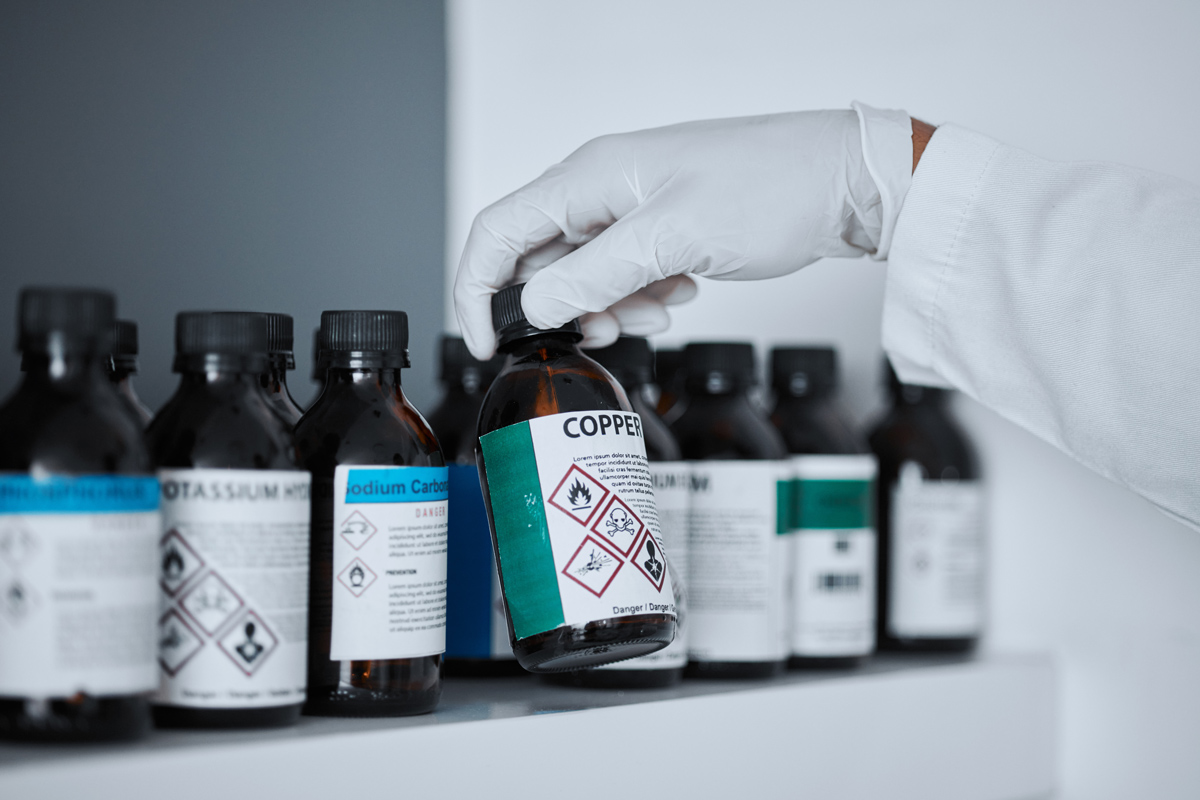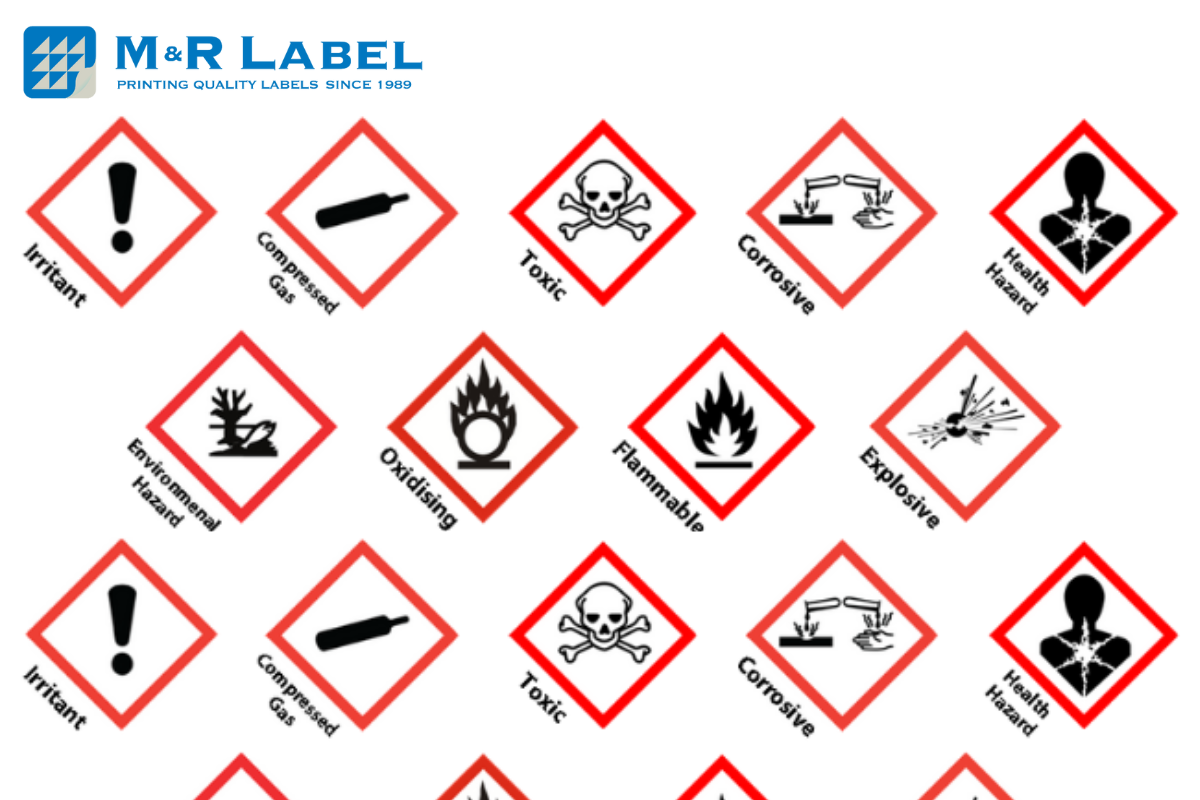Is your company handling harmful chemicals or industrial style chemical containers? Safety is the number one priority in industrial applications and chemical handling. For businesses dealing with (and/or manufacturing) these products, responsible chemical label protocol is imperative. It helps ensure the safety of all personnel who use and come into contact with your products.
In the fast-paced world of industrial and chemical handling, personal safety is paramount! Whether you’re managing a bustling warehouse or a high-tech factory floor, ensuring your team’s safety and complying with regulations is non-negotiable. Central to this is understanding and implementing proper labeling protocols, particularly by the Globally Harmonized System (GHS) standards.
It’s vital to protect your team and customers by following the best practices for labeling industrial chemicals. Are your hazardous chemical labels up to GHS code?
What is GHS Labeling?
The Globally Harmonized System of Classification (GHS) is a standardized labeling system adopted by the UN for all chemical products. These international standards apply to all companies dealing with chemicals:
“In 2003, the United Nations (UN) adopted the Globally Harmonized System of Classification and Labeling of Chemicals (GHS). The GHS includes criteria for the classification of health, physical and environmental hazards, as well as specifying what information should be included on labels of hazardous chemicals as well as safety data sheets. The United States was an active participant in the development of the GHS, and is a member of the UN bodies established to maintain and coordinate implementation of the system.” – OSHA
With proper GHS labeling, companies trade internationally as all chemical handling businesses classify and communicate chemical hazards in the same way. It eliminates any confusion or misalignment, making the trade and handling much more secure.
Why is this practice crucial for hazardous chemicals?
For any individuals handling chemicals, domestic or industrial, knowing the accurate way to designate GHS labels is important. It guides your team on how to use the chemicals safely and avoid hazards associated with dangerous and corrosive substances. In case of emergencies, users are also made aware of the appropriate response plan to secure themselves against any potential damage.
“Chemicals, through the different steps from their production to their handling, transport and use, are a real danger for human health and the environment. People of any ages, from children to elderly, using many different languages and alphabets, belonging to various social conditions, including illiterates, are daily confronted to dangerous products (chemicals, pesticides, etc.).” – United Nations
The Top Benefits of Adhering to GHS Label Requirements
Complying with the GHS labeling requirements offers companies like yours many benefits. These include…
- Safety: When chemicals are labeled correctly, they reduce the chances of accidents at workplaces, making them more secure.
- Global Compliance: GHS labels are global standards. Compliance ensures more trade opportunities and cooperation across borders.
- Risk Mitigation: By providing comprehensive hazard information, GHS labels enable risk assessment and effective risk management plans.
- Legal Compliance: Meeting GHS labeling regulations ensures compliance with legal frameworks. It secures businesses against fines and penalties.
- Improved Communication: With standardized labeling, communication becomes easier among stakeholders, especially across borders where language may be a barrier to communication.
Understanding the GHS Guidelines and Symbols
GHS chemical labels typically feature pictograms, signal words, hazard statements, and precautionary statements. Each element serves a distinct purpose in conveying crucial safety information. For instance, pictograms illustrate the hazards of the chemical, while signal words like “Danger” or “Warning” indicate the severity of the risk.
The GHS has nine pictograms or symbols that are used to warn users about the chemicals they are in contact with. The pictograms that apply must be included in the label exactly as mentioned by the GHS. They are printed on a white background with a red, diamond-framed border. For labels to be compliant, the symbol must be copied exactly.
Knowing these symbols well is essential for ensuring proper interpretation and adherence to safety protocols. It empowers workers to recognize hazards at a glance and take appropriate precautions, minimizing the likelihood of accidents and injuries.
What needs to be included in a chemical label?
Custom chemical product labels are crucial modes of communication and risk management. Hence, the GHS guidelines go beyond compliance. They need to be accurate in order to truly serve their purpose. According to the guidelines, here are the six elements your custom product labels must contain:
Signal Word
The signal word is used to explain the intensity of the health hazard. Danger is used for severe hazards and Warning for less severe ones. A single word makes it clear and simple to understand for everyone.
Pictograms
These are universally readable symbols that specify specific hazards. Chemical labels can contain more than one symbol depending on the chemicals.
Hazard Statements
There can be multiple hazard statements per label. These signify the magnitude of the danger and the symptoms that may occur if you come into contact with the chemicals.
Product Identifier
The product identifier is used to identify the dangerous chemical or ingredient present in the product. It is often placed in the top left-hand corner. The state name is mentioned so people can identify the chemical.
Precautionary Statements
The precautionary statements inform workers and users about how they can reduce the harmful effects of the chemical through careful use. The statements generally include instructions about storage, prevention, appropriate response, and careful disposal.
Supplier Information
All GHS chemical labels must include supplier information. The manufacturer’s name, address, and contact details must be mentioned to reach out in an emergency. The 6 GHS components ensure that adequate information is provided for the safety of the chemical’s users. Information is made easy to read and access.
Accurate GHS Chemical Labeling with M&R Label
When it comes to chemical products, there are a few considerations you must be aware of. Your labels must be clear and legible so people can access information easily. They also need to be durable so they can tolerate the harsh conditions of various industrial settings. Labels that chip or fade away can be dangerous, and could land you in serious legal trouble if an emergency occurs due to faulty labeling.
Choosing a Trusted Custom Label Vendor
When it comes to sourcing premium GHS industrial and chemical labels, M&R Label stands out as a trusted partner. With a commitment to accuracy, quality, and compliance, M&R Label offers a comprehensive range of customizable solutions tailored to your needs. From label design to printing, our expert team will ensure that your labels meet regulatory requirements while effectively communicating hazard information. And let’s not forget about quality!
Prioritizing GHS labeling in your chemical handling practices is a commitment to safety, sustainability, and responsible business practices. By embracing standardized labeling protocols and partnering with an experienced professional like M&R, you can safeguard your workforce, protect your bottom line, and demonstrate your dedication to safety excellence. In a world where every label tells a story, let yours speak volumes about your commitment to safety and compliance!




